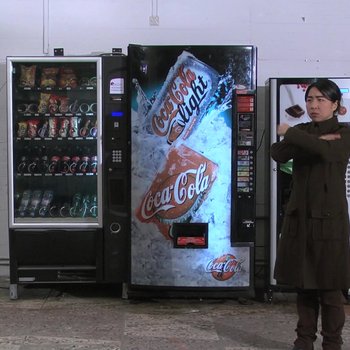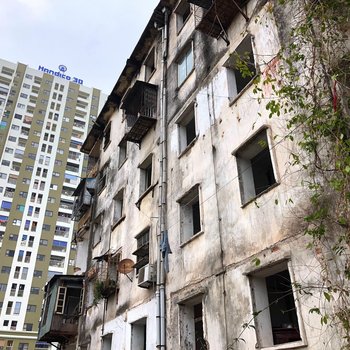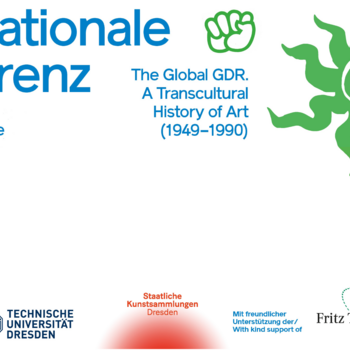Anti-imperialist solidarity
In the political lingo of the GDR, the term anti-imperialist solidarity expressed its relationships to non-aligned states and organisations at the time, especially to those fighting against colonial powers. This solidarity brought with it economic and military support, which largely served to promote socialism. At the same time, the GDR also used it to pursue economic interests of its own. For example, the GDR invested in coffee plantations in Angola and Vietnam in the hope of sourcing coffee from these countries.
Miriam M. Müller: A Spectre is Haunting Arabia. How the Germans Brought Their Communism to Yemen, Bielefeld 2015, S. 124.
DDR Museum Berlin, »Antiimperialistische Solidarität« – Entwicklungshelfer der DDR in Asien (14.1.2016), Link (retrieved on 1 September 2023).
Henning von Löwis: Antiimperialistische Solidarität, in: R. Eppelmann, H. Möller, G. Nooke, D. Wilms (Hgg.): Lexikon des DDR-Sozialismus, Bd. 1, Paderborn 1997, S. 74¬–75.
Apartheid
The word Apartheid (from the Afrikaans) means “separateness” and describes the policy of racial segregation in South Africa and Namibia, which led to systematic privileges for whites and discrimination against blacks and BIPoC (Black, Indigenous, People of Color) in all aspects of life. The GDR government supported the fight against apartheid at international level and propagated it, in spite of its own domestic racism problems. For example, the expatriated black South African singer and activist Miriam Makeba performed at the Xth World Sports Festival for Young People and Students in East Berlin in 1973.
Andreas Bohne, Bernd Hüttner, Anja Schade (Hgg.): Apartheid No! Facetten von Solidarität in der DDR und BRD, 2019, Link (retrieved on 1 September 2023).
H. Schneider, Apartheid (8.6.2022), Link (retrieved on 1 September 2023).
Sebastian Gehrig: Reaching Out to the World. East Germany's Anti-Apartheid and Socialist Human Rights Campaign, in: German History, 36:2018, Heft 4, S. 574–597.
Gaze
Gaze is an English word used internationally, a use that originates in film theory. It describes how our way of seeing and interpreting what we see is inextricably linked to societal standards and power structures. The white gaze, for example, shows how white people see a person or events: white realities, norms and experience are to the fore, while the perspective of BIPoC* remains in the background or invisible.
Informations- und Dokumentationszentrum für Antirassismusarbeit e.V.: Weißer Blick (White Gaze), Link (retrieved on 1 September 2023)
Paula Amad: Visual Riposte. Looking Back at the Return of the Gaze as Postcolonial Theory's Gift to Film Studies, in: Cinema Journal 52:2013, Heft 3, S. 49–74.
Corinn Columpar: The Gaze As Theoretical Touchstone. The Intersection of Film Studies, Feminist Theory, and Postcolonial Theory, in: Women's Studies Quarterly 30:2002, Heft 1 u. 2, S. 25–44.
Global art history
The term global art history was coined in the 1980s and was initially seen as a phenomenon of contemporary art. Today, this research area is considered to encompass a critical interrogation of Euro-centric art history and its methods. Global art history develops its own language and methods to research art as international, mobile, dynamic and multi-perspective.
Hans Belting: From World Art to Global Art. View on a New Panorama, in: The Global Contemporary and the Rise of New Art Worlds, Ausst.-Kat. ZKM Zentrum für Kunst und Medien, Karlsruhe 2012, hg. v. Hans Belting, Andrea Buddensieg, Peter Weibel, Cambridge 2013, S. 178–185.
Mariachiara Gasparini und Monica Juneja, Interview with Monica Juneja about Global Art History (29.01.2014), Link (retrieved on 1 September 2023).
Global South
The terms Global South and Global North describe how there are privileged and disadvantaged positions in a globalised world, a status quo that has its roots in colonialism and persists to this day. According to social, economic and political criteria, this means that the Global South is still disadvantaged and the Global North is still privileged. The term should only be understood in its geographical sense to a limited extent, and replaces Euro-centric and hierarchical categories based on purported “development criteria”.
glokal e.V. (Hg.): Mit kolonialen Grüßen …. Berichte und Erzählungen von Auslandsaufenthalten rassismuskritisch betrachtet, Berlin 2013, S.8.
Cuban Revolution
The Cuban Revolution was a social and political movement headed by Fidel Castro that overthrew the dictator Fulgencio Batista in Cuba in 1959 with broad political support across all population groups and led to the establishment of socialism. However, it would take several years for Cuba to turn to other socialist countries. Cuba differed ideologically from these states, in art among other things. The influence of the pre-revolutionary American film industry and abstraction, as revealed in the pop art-style posters among other things, was acceptable in Cuba, in keeping with the credo “Our enemy is capitalism, not abstract art”. This clearly differentiated the country’s art scene from the GDR’s socialist realism.
Michael Zeuske, Traditionen, Gegenwart und Zukunft der kubanischen Revolution (4.10.2010), Link (retrieved on 1 September 2023).
Tricontinental. Institute for Social Research, The Art of the Revolution Would be Internationalist (8.4.2019), Link (retrieved on 1 September 2023).
Cultural appropriation
The term cultural appropriation describes the unthinking use of the cultural elements of a structurally disadvantaged or minority group by a dominant, privileged group. This can include symbols, language or cultural practices, for example.
In the discourse on the term, certain groups differ in their understandings and assessments. Some groups downplay historical facts and violence under the pretext of “artistic freedom”.
Diskriminierungskritische Perspektiven an der Schnittstelle Bildung/Kunst: Kulturelle Aneignung, Link (retrieved on 29 September 2023).
Stiftung gegen Rassismus und Antisemitismus: Kulturelle Aneignung (2022), Link (retrieved 1 September 2023).
Migration in the GDR
Migration has shaped the GDR since its establishment. Political refugees came from Spain, Greece and Chile, among other places. Starting in the 1950s, international students also came to the GDR. Students from non-aligned and western states brought foreign currencies to the GDR. In contrast, students from socialist countries came for ideological reasons. Starting in the 1980s, migrant workers came from the same countries, primarily to support the East German economy. In 1989, estimated 190,000 people (1.17% of the population) in the GDR were foreign nationals.
Patrice G. Poutrus, Ausländer in Ostdeutschland (24.8.2020), Link (Stand: 18.8.2023).
Andrea Pürckhauer und Paulina Lorenz, Welche Migration gab es in der DDR? (8.11.2019), Link (retrieved 21 August 2023).
Jochen Oltmer, Die DDR – Eine Migrationsgesellschaft? (4.6.2021), Link (retrieved 1 September 2023).
Othering
Othering is an English word used internationally to describe the practice of segregating one person or group from another. As part of this, the group to which a person does not belong is defined as the “other” and looked down on, attributing to them negative characteristics that are outside acceptable standards. If there is an imbalance in power, this attribution causes disadvantages in society.
Vielfalt Mediathek, Othering, Link (retrieved on 1 September 2023).
Zürcher Hochschule der Künste, Othering, Link (retrieved on 1 September 2023).
Diversity Arts Culture, Othering, Link (retrieved on 1 September 2023).
Anna von Rath, Lucy Gasser, Othering ~ Andern: 10 Schwierig zu übersetzende Begriffe In Bezug auf Identitäten, Link (retrieved on 1 September 2023).
Postsocialism
The term postsocialism was primarily used by western academics studying the fall of the USSR and the Warsaw Pact between 1989 and 1992. The term was originally used in research on the economic and political changes after the collapse of socialist systems. The focus of the research on eastern and central Europe, as well as on the sense of a new dawn in the events is (now?) controversial. For example, this research ignored perspectives from other parts of the world and existing structures and continuities at local level.
Alison Stenning: Postsocialism, in: Tim Forsyth (Hrg.), Encyclopedia of International Development. Abingdon 2005, S. 551–553.
Martin Müller: Goodbye, Postsocialism! in: Europe-Asia Studies, 71:2019, Heft 4, S. 533–50.
Coup in Chile 1973
On 11/9/1973, the Chilean army launched a coup against the elected socialist government under Salvador Allende. The persecution and murders under the coup’s leader Augusto Pinochet forced many people, among them artists, to seek refuge in other countries. Chilean artists (in exile) around the world created art in remembrance of those murdered and to protest against Pinochet. In the GDR, the government played a part in ensuring that the art scene addressed this topic: artists – though mostly from the GDR – were commissioned to create public monuments to honour Salvador Allende.
John Simalchik: The Material Culture of Chilean Exile. A Transnational Dialogue, in: Refuge: Canada's Journal on Refugees, 25:2016, Heft 23, Nr.2, S. 95–105.
Junge Welt, Buchvorstellung: Chile 1973. Denkmäler und Wandbilder in DDR und BRD (14.7.2023), Link (retrieved on 1 September 2023).
Racism in the GDR
The GDR claimed to have successfully overcome fascism, Antisemitism and racism as part of the class struggle. This fundamental principle meant that the reality, where these problems remained present, was often ignored. Recent research shows that not only was discrimination rife among the general population, it was also supported at government level. Contract workers in particular were disadvantaged and segregated.
Harry Waibel: Der gescheiterte Antifaschismus der SED-Antisemitismus, Rassismus und Neonazis in der DDR, in: Journal EXIT-Deutschland Zeitschrift für Deradikalisierung und demokratische Kultur: Alter & Neuer Rechtsradikalismus. Bemerkungen zur Historie und Lage in Deutschland, 8:2016, Heft 2, S. 40–67.
Ines Grau: »Aber das ist eigentlich nach der Wende …« von Brüchen und Kontinuitäten rassistischer Erfahrungen mosambikanischer Arbeitsmigrant:innen in der DDR bis in die Gegenwart, in: Institut für Demokratie und Gesselschaft (Hg.): Wissen schafft Demokratie. Tagungsband zur Online-Fachtagung Gesellschaftlicher Zusammenhalt & Rassismus, Band 11., Jena 2022, S. 118–127.
Agneta Jilek: Fremde Freunde. Vietnamesische Vertragsarbeiter in der Fotoserie Ly's Geburtstag (1986–1989) von Matthias Rietschel, in: Dresdner Institut für Kulturstudien e.V. (Hg.): Arbeit! Ostdeutsche Arbeitswelt im Wandel 1945–2015, Dresden 2015, S. 202–207.
Socialist chromatism
According to Quinn Slobodian, socialist chromatism describes a common motif that also featured in visual arts from the GDR: several persons of different skin colour are depicted with stereotypical physical and cultural characteristics. Slobodian saw the unthinking use of racially charged ethnographic models and placement of a white figure as a leading element in the image as a contradiction of the supposedly anti-racist and anti-imperialist stance of the GDR.
Quinn Slobodian (Hg.): Comrades of Color. East Germany in the Cold War World, New York/Oxford 2015, S. 23–42.
Socialist imperialism
Under Stalin, the USSR took on imperial form when he once again propagated Russian culture in a country of many peoples – against the decision of Lenin, who wanted to foster the nationalist feelings of the nations (Ukraine, Belarus, etc.). After World War II, military invasions of Warsaw Pact signatories and the spread of Soviet-style socialism served to maintain and disseminate the USSR’s hegemony worldwide. This concept was first used by the People’s Republic of China, among others, in the 70s.
Albert Szymanski: Soviet Social Imperialism, Myth or Reality. An Empirical Examination of the Chinese Thesis, in: Berkeley Journal of Sociology 22:1977, Heft 22, S. 131–166.
Manfred Wilke, Steffen Alisch: Internationalismus, proletarischer und sozialistischer, in: R. Eppelmann, H. Möller, G. Nooke, D. Wilms (Hgg.): Lexikon des DDR-Sozialismus, Bd. 1, Paderborn 1997, S. 414–416.
Terry Martin: An Affirmative Action Empire. The Soviet Union as the Highest Form of Imperialism, in: Ronald Grigor, Terry Martin (Hg.): A State of Nations. Empire and Nation-Making in the Age of Lenin and Stalin, New York 2001, S. 67–90.
Gerd Schneider und Christiane Toyka-Seid, Sowjetunion (UDSSR), Link (retrieved on 1 September 2023).
Friendship of peoples
The term friendship of peoples (дружба народов/druzhba narodov)1 was coined in 1930s’ USSR to unite the various ethnographic groups in the population. The principle underlying this term is the notion that the workers of all countries were in a class struggle against the nationalist bourgeoisie, and thus united in friendship. The term was used in foreign policy from 1970 on, to present a positive image of the GDR overseas, especially to new independent states.
.
Birgit Wolf: Sprache in der DDR. Ein Wörterbuch (S. 238–239).
Terry Martin: An Affirmative Action Empire. The Soviet Union as the Highest Form of Imperialism, in: Ronald Grigor, Terry Martin (Hg.): A State of Nations. Empire and Nation-Making in the Age of Lenin and Stalin, New York 2001, S. 67–90.
(1) The Great Soviet Encyclopedia, Friendship of Peoples, Link (retrieved on 1 September 2023).
Vietnam War
The Vietnam War was fought from 1955 to 1975 and its impact is still felt in Vietnam and Germany today. In the GDR, backed by the Solidarität hilft Siegen (Solidarity helps bring victory) programme among others, educational institutions began accepting pupils and scientists from Vietnam in 1955. The economic cooperation led to the residential buildings in the city of Vinh, which remain in use today. Many former Vietnamese contract workers still live in Germany with their families.
Ronald H. Spector, Vietnam War. 1954–1975 (31.8.2023), Link (retrieved 1 September 2023).
Karin Weiss, Vietnam. Netzwerke zwischen Sozialismus und Kapitalismus (30.6.2005), Link (retrieved 23 August 2023).
Christina Schwenkel: Den globalen Sozialismus aufbauen. Zur Geschichte der DDR-Stadtplanung in Vinh, In: ARCH+ 49:2016, Heft 226/227, S. 30–41.

Also of interest:
Qingmei YAO's film “The Trial” is currently showing in our series on China, as part of the “Counterpoints” project. The film is conceived as an absurdist stage play in which Yao herself performs as a military figure in uniform, interrogating a Coke vending machine. In this interview she talks about how the idea came about and the ambivalence of China’s position straddling socialism and turbo-capitalism.

The annihilation of Vinh City by US bomb raids offered an opportunity for experimental planning and for transforming the small industrial town into a model socialist city. The GDR’s ambitious task of comprehensive reconstruction involved working collectively on both the creation of a master plan and its realization in built form. Christina Schwenkel on the Quang Trung housing complex.

For the “Counterpoints” project, the SKD are studying the international history of the East German cultural sector - a project about the history of their own collection; about dialogue and networking. Above all, however, it is about correcting the narrative describing that history as provincial and isolated from modernism. In June, TU Dresden’s Chair of Visual Culture Studies in a Global Context organised a conference on the ties between the GDR cultural sector and the Global South, working with the Albertinum and the TU Office for Academic Heritage, Scientific and Art Collections.
